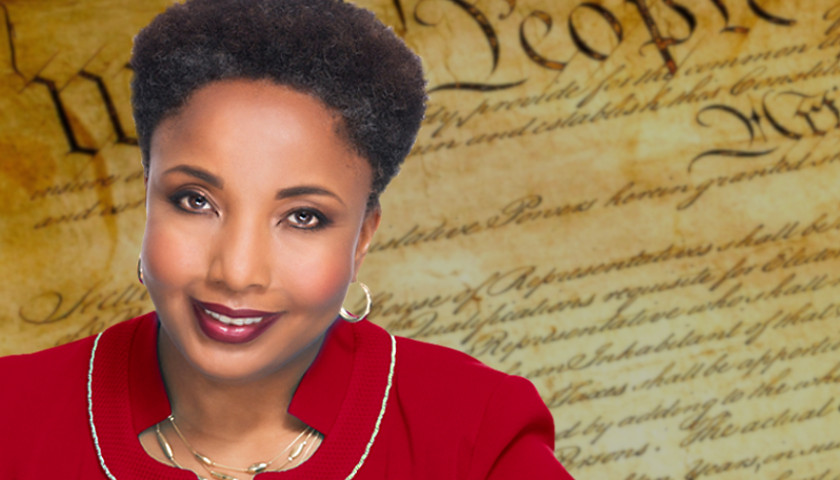by Carol M. Swain
Under the guise of a venture called the “1619 Project,” revisionist history about race in America is being introduced into classrooms across America without undergoing the normal peer review expected of educational materials. August 2019 marked the birth of the project, a publication of The New York Times Magazine and the Pulitzer organization, containing a collection of essays and artistic works to commemorate the 400-year anniversary of slavery in America. The project has mushroomed into a movement to re-educate Americans via newfangled claims about how deeply racism is embedded in America’s core.
As of February 2020, five public school systems had adopted the 1619 Project’s curriculum district-wide, and its free teaching materials had reached 3,500 classrooms. This rapid progression for distribution of teaching materials created by journalists and scholars has been done without proper vetting. There has been no standard review process or serious effort made to address the many concerns raised by distinguished subject-matter critics from elite universities. The rush to get these materials into America’s classrooms proceeded recklessly.
What has ensued is a new racial narrative that places black America’s struggles at the feet of the nation’s white Founding Fathers. This requires a new birthdate for the nation. Instead of July 4, 1776, when the Founders signed the Declaration of Independence pledging to risk their lives, fortunes, and sacred honor to found a new nation, the 1619 Project scholars place the inception of the nation more than 150 years earlier — at 1619. That’s when the first Africans came to Virginia as indentured servants before becoming free blacks.
Curiously, and inexplicably, the revisionist narrative skips over the 42 years of indentured servitude that enabled the former slaves to gain the freedom and resources to become the foundation of the free black population in America.
Jake Silverstein of the Times has written that the arrival of enslaved Africans “inaugurated a barbaric system of chattel slavery that would last for the next 250 years.” Conspicuously absent from the dominant historical narrative is the fact that free blacks and Indian tribes were right there alongside whites, buying and selling slaves after slavery became legal in 1661.
Historian Philip Foner, in his book “History of Black Americans,” provides critical details that American students should know about the origins of slavery in America:
“The fact that the early Negroes imported into Virginia held the status of indentured servants is shown by the records of some Negroes’ receiving the customary ‘freedom dues’ in the form of land at the end of their term of service. Some obtained land after becoming free by importing servants under the ‘head-right’ system, by which they obtained 50 acres for each servant imported. A small number of Negro landowners not only held black servants, but were sufficiently prosperous to pay the transportation costs of white indentured servants, through each of whom they could obtain 50 acres of land. Anthony Johnson, who was imported into Virginia in 1622, accumulated property after he ended his indentured period, and even though he lost all his holdings in a fire, was able by 1651 to import five black servants into the colony, for which he was granted 250 acres in Northampton County. About 1650, Benjamin Dole, a Negro, was granted 300 acres of land in Surry County for having imported six servants. Another Negro was granted 550 acres after importing 11 people.”
Clearly, this account differs substantially from the narrative advanced by the 1619 Project contributors. What some of them hope to do is to build a case for monetary reparations for descendants of slaves. This is a false hope that would not address the problems many blacks have today, or the enormous progress black Americans overall have made.
Those who push white guilt and black victimhood ignore critical facts. One is that today’s white Americans are not responsible for the sins of generations ago. Second, slavery was an institution that blacks, Native Americans, and whites participated in as slaveholders. There’s plenty of guilt to go around there.
Critical Race Theory and the Diversity Inclusion Industry
Critical race theory is an analytical framework to analyze institutions and culture. Its purpose is to divide the world into white oppressors and non-white victims. Instead of traditional forms of knowledge, it uses personal narratives of marginalized minority “victim” groups (blacks, Hispanics, Asians) as irrefutable “evidence” of the dishonesty of their mostly white heterosexual oppressors. The ultimate goal of this theory’s proponents is to remake society so that the victim class eventually displaces the oppressors and becomes the new ruling class.
Within this framework, white privilege and its unearned benefits are responsible for economic, health care, and social disparities in minority communities. It advances a narrative of blame that declares white America guilty for the plight of blacks. When it comes to education, members of the victim classes do all the teaching. It is a worldview and narrative that commands white people to sit in obedience and listen quietly to the arguments about their unjust gains as well as their obligation to provide a remedy for — in this case, black Americans, whether they are descended from slaves or not.
There is no way out for whites when it comes to race. Critical race theory assumes that racism is permanent and affects every aspect of our society, including political, economic, social and religious institutions. The theory further advances the belief that being born with white skin, in itself, gives unearned privileges. Therefore, any expectation of societal attainment of colorblindness, in which race or ethnicity does not hinder opportunities, is impossible to be achieved. Neutrality in law and decision-making is a pipe dream that can never be attained. Therefore, this mistaken reasoning goes, the oppressive system must be dismantled and destroyed.
This flawed theory suggests that race and ethnicity will always taint and pollute every decision, and, as a result, racial minorities will consistently lose out to whites because of structural racism. The message is clear: If you are unfortunate enough to be born with black skin, you are forever a second-class citizen who pays a race penalty. Under this rationale, the most affluent blacks rank below the poorest whites when it comes to privilege and opportunities. We are asked to believe that more than 50 years of affirmative action programs and race consciousness have done nothing to change the trajectory or opportunities of people born without white skin. Critical race theory says every dysfunctional condition in black, urban communities can be traced to slavery and its aftermath. There is no place for individual-choice initiative.
What critical race theory actually “accomplishes” is to create anger, frustration, and despondency among persons in the victim categories who internalize the destructive message.
Universities and colleges have created a cottage industry of people who profit from indoctrinating America’s future leaders with a dangerous and destructive ideology. These future leaders then spread this diseased ideology, like a virus without an antidote, into corporate boardrooms as well as K-12 public and private schools, both Christian and non-Christian. Standards normally used to reward academic credentials are sometimes relaxed to give more authority to watered-down factors such as “personal experience” and the narrative of victim-class members and less credence to whatever facts, science, and contrary data that persons from the “oppressor” class might dare to proffer.
Education is now about white privilege indoctrination. According to the narrative, all white Americans are guilty oppressors who have benefitted from their white skin even if their parents are, say, Appalachian poor or high school dropouts working at the local big box franchise store (if employed at all). Once the oppressor label is applied, accepted, and internalized, a deadly silencing ensues. In some cases, animated videos with messages of white guilt and oppressions shown to middle and high school students create damaging images where whites are taught guilt and minorities are assigned permanent and debilitating victimhood.
One notorious example of the “teaching” materials for diversity and sensitivity training is a short YouTube video entitled, “The Unequal Opportunity Race.” It has had more than 1.3 million views as of this writing. Its crippling message is clear: White boys and girls have unfair advantages, and white-imposed roadblocks prevent black boys and girls from achieving success.
Last year, the office of instruction for Westfield (N.J.) Public Schools approved a course on “Power, Privilege, and Imbalance in American Society.” Learning objectives of the semester-long, two-credit course include how to:
- Analyze and evaluate how white supremacy has been established in American society and the ways it continues to impact the African American, Native American, Hispanic, and Asian communities today; and
- Identify the concept of race and differentiate between the terms “racism,” “prejudice,” “dejure” and “de facto segregation,” “institutional racism,” “personal racism,” “tolerance” and “intolerance.”
The syllabus explains that critical race theory is a theoretical concept that emerged from the civil rights movement. The goal is to “give voice to groups who have suffered from systemic oppression, and develop theoretical and practical ways for students to deconstruct the power structures.”
Messages Matter
The 1619 Project is a misguided effort to keep open historical wounds while telling only half of the story. It is flawed because it is connected to critical race theory and the diversity-inclusion grievance industry that focuses on identity politics and division. Blaming today’s families for the mistakes of our ancestors is not a prescription for unifying the country or empowering racial and ethnic minorities.
We can do better. Within Christian communities, there is a basis for countering destructive narratives that have invaded our educational institutions and corporate world. The solution for hatred, bitterness, and distrust can be found in New Testament principles. Rather than wallow in the past and revisionists’ efforts to build a case for reparations, we, as Americans, need to move forward while practicing the forgiveness and love of neighbor that Jesus espoused. We need not look any further than the “golden rule” (do unto others as you would have them do unto you) to find the tools that enable us to transcend racial and ethnic conflicts that keep us from working together and celebrating our victories. Our present approach cripples members of the designated victim groups while creating new victims among those classified as oppressors.
I speak from a personal perspective as someone who has watched the changes from many vantage points. I reached my formative years before critical race theory and cultural Marxism gained a dominant foothold. Even though I was born and grew up in rural southern poverty during the era of segregation, I was not taught to hate white people or to hate America. Instead, my black teachers stressed our need to work hard and excel. I grew up to be a proud American who never doubted she lived in the greatest country in the world. No one around me encouraged me to see myself as a victim. I never fixated on the fact that I was black, poor, and female. Had I done so; I doubt I would have achieved anything.
– – –
Carol M. Swain is a former tenured professor at Vanderbilt and Princeton universities. Her Be The People News blog and podcast empower individuals to think independently, understand their responsibility, and make a difference in the world.






So when is Carol Swain going to announce her 2024 candidacy? If and when she does, she’ll have my vote!
Great article, Dr. Swain. Every American should read it!
Swain, the next thing you will tell us is that slaves were content with being slaves and hostile toward the Abolitionists. Many white slave-owners kidded themselves into believing that slaves were content. But, if the white owners genuinely felt this way, then why did they feel the need to arm themselves to the teeth, to inflict brutal punishment on any slave, free black, or white who displayed any discontent or disagreement toward slavery? Why did these wealthy whites feel the need to suppress any dissent over the slavery issue by intercepting the mail or by assaulting abolitionists like Amos Dresser in Nashville during 1840? More important, why did so many slaves attempt to flee either to be reunited with their families forcibly broken up by slavery and/or by a desire for freedom in the Free-Soil states? You would have to be a brainwashed Aunt Jamima (a female Uncle Tom) to believe such right wing garbage.
William, your point of view and comments are exactly what Dr. Swain is writing about. When I moved South I made the effort to read as much unbiased history as I could find about the South including the Northern War of Aggression, slavery, reconstruction, and the events that lead up to the “Civil War”. What I found is that the narrative I was fed while living “up North” was so full of falsehoods and half truths that I was amazed.
Also, I find your comment “…..a brainwashed Aunt Jamima” repulsive and racist. But that is always the case with Liberalism, the hypocrisy is so think you could cut it with a knife. Thank you Dr. Swain for the well written commentary.
William, you need to improve your reading comprehension skills. There is absolutely nothing in Dr. Swain’s article that could possibly be construed as defending or justifying slavery or the actions of slave-owners. But when we start condemning such actions, let’s make sure we’re condemning the right people. And that is what Dr. Swain’s article is really about.
Instead of understanding and recognizing such things as the difference between indentured service and slavery (and yes , there is a HUGE difference), or the fact that slave ownership wasn’t limited to white people, or that black people weren’t the only ones who were enslaved (especially so if you look at the broader issue of slavery around the world over the last several thousand years, and continuing to this day), you have chosen to dredge up a bunch of irrelevant and totally unrelated stories from two centuries ago to prove what? That slavery was, and is, evil? We already know that, and I’m sure you would get no disagreement from Dr. Swain on that point, so stop wasting your efforts on trying to prove what is already established fact.
And, as far as your disgusting and racist “Aunt Jamima” [sic] comment is concerned, that is totally unacceptable, and I’m surprised that the moderators let that slip through. Maybe they decided to let everyone see who the real racist is.